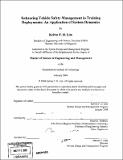| dc.contributor.advisor | Stuart E. Madnick. | en_US |
| dc.contributor.author | Lim, Kelvin F. H. (Kelvin Fang Hui) | en_US |
| dc.contributor.other | System Design and Management Program. | en_US |
| dc.date.accessioned | 2008-11-07T19:04:43Z | |
| dc.date.available | 2008-11-07T19:04:43Z | |
| dc.date.copyright | 2008 | en_US |
| dc.date.issued | 2008 | en_US |
| dc.identifier.uri | http://hdl.handle.net/1721.1/43118 | |
| dc.description | Thesis (S.M.)--Massachusetts Institute of Technology, System Design and Management Program, 2008. | en_US |
| dc.description | Includes bibliographical references (p. 180-186). | en_US |
| dc.description.abstract | Organization Sierra-Tango is employing a systematic and methodical safety framework to manage risks in all their operational and training activities. While this safety system has shown itself to be reasonably effective in curtailing the number of accidents within the organization, Organization Sierra-Tango is not resting on its laurels and is continuing efforts to refine and improve upon its safety management framework. One of the focus areas is that of enhancing vehicle safety management in training deployments.This thesis fulfills Organizations Sierra-Tango's need for systematic understanding and continuous learning to enhance vehicle safety management in training deployments. This is achieved by extending the preponderant focus on the events and symptoms of accidents, which mostly ascribe human error as the primary cause of accidents, towards a more holistic perspective of accidents by also examining the often complex and dynamic contribution of organizational policies and practices towards accidents. An extensive research process was undertaken where discussions and interviews were conducted with the organization's vehicle safety Subject Matter Experts so as to develop a better understanding of the context of vehicle accidents during training deployments. Additionally, a thorough review of Organization Sierra Tango's internal documents (accident reports, training policies, etc) and open literature on accidents and safety was performed. Two System Dynamics (SD) models were developed to synthesize the mental models from the research phase and to generate, through simulations and analysis, insights for enhancing the organization's vehicle safety framework and practices. | en_US |
| dc.description.abstract | (cont.) The key insights drawn from the Work Management SD model are that, schedule pressure must be managed at all levels, driver workload should be relieved by increasing the number of drivers available rather than task reduction, and supervisor workload management has a larger bearing on a driver's accident resilience compared to driver workload management. The Near Miss Reporting SD model revealed that increasing the level of identity confidentiality of near miss reporters encourages reporting, reducing the severity of punitive measures is not recommended as a means to encourage near miss reporting, and the overall safety culture of the organization is a key driver of near miss reporting. | en_US |
| dc.description.statementofresponsibility | by Kelvin F. H. Lim. | en_US |
| dc.format.extent | 186 | en_US |
| dc.language.iso | eng | en_US |
| dc.publisher | Massachusetts Institute of Technology | en_US |
| dc.rights | M.I.T. theses are protected by
copyright. They may be viewed from this source for any purpose, but
reproduction or distribution in any format is prohibited without written
permission. See provided URL for inquiries about permission. | en_US |
| dc.rights.uri | http://dspace.mit.edu/handle/1721.1/7582 | en_US |
| dc.subject | System Design and Management Program. | en_US |
| dc.title | Enhancing vehicle safety management in training deployments : an application of system dynamics | en_US |
| dc.type | Thesis | en_US |
| dc.description.degree | S.M. | en_US |
| dc.contributor.department | System Design and Management Program. | en_US |
| dc.identifier.oclc | 245533819 | en_US |

